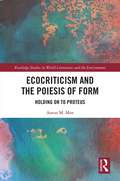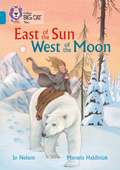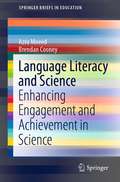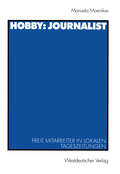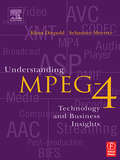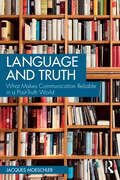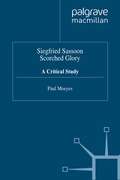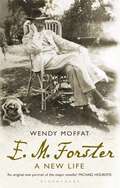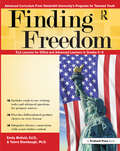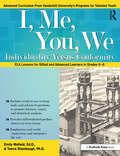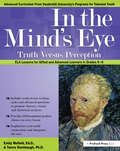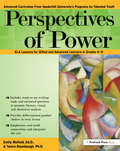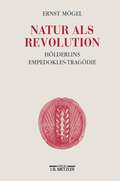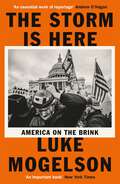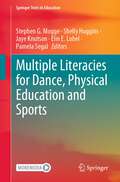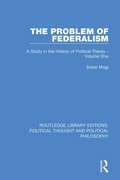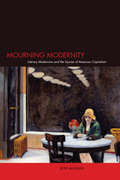- Table View
- List View
Ecocriticism and the Poiesis of Form: Holding on to Proteus (Routledge Studies in World Literatures and the Environment)
by Aaron M. MoeEcocriticism and the Poiesis of Form: Holding on to Proteus demonstrates how a fractal imagination helps one hold the form of a poem within the reaches of Deep Time, and it explores the kinship between the hazy, liminal moment when Sound becomes Syllable and the hazy, liminal moment when the sage energy of the Atom made a leap toward the gaze of the first cell, to echo Merwin. Moe distills his methodology as follows: "My work?—I point," asserted the aphorism. "That’s what I do." To point, the project integrates a wide range of interdisciplinary ideas—including biosemiotics, fractals, phi, trauma theory, the Mandelbrot Set, hyperobjects, meditative chants, Goethe’s morphology, Ramanujan’s summation, a spiderweb’s sonic properties, and Thoreau’s sense of the plant-like burgeoning force of an Atom—in order to open up multiple trajectories. In this context, the volume foregrounds the insights of poets/storytellers including Hillman, Snyder, Anzaldúa, EEC, okpik, Whitman, Dickinson, Gladding, Melville, Morrison, and Toomer, for they are most attentive to that liminal moment when the vibratory hum in language, and in the cosmos, turns kinetic. As this volume draws on a wide range of writers from many backgrounds, it allows the myriad voices to engage with one another across differences in race, gender, and ethnicity. These writers show us how, to echo Dickinson, the "Freight / Of a delivered Syllable - " can split and how the energy unleashed came from, and points us back toward, the energy (un)making the forms of Gaia. The starting point for discussing the energy of a poem can no longer begin with the human; rather, Holding on explores how the poem’s energy is but a sliver of a hyperobject "massively distributed" throughout the cosmos—a sage energy that brings forth form.
Collins Big Cat, Band 13, Topaz: East of the Sun, West of the Moon (PDF)
by Jørgen Engebretsen Moe Jo Nelson Peter Christen AsbjørnsenFollow Rosa's magical journey across the snow and ice towards a mysterious prince, who she must rescue in order to unlock her own true happiness. This beautiful retelling of an other-worldly traditional tale, wonderfully describes Rosa's unexpected voyage.
Language Literacy and Science: Enhancing Engagement and Achievement in Science (SpringerBriefs in Education)
by Azra Moeed Brendan CooneyThis book presents the findings of two case studies in the 'Making Connections' two-year project funded by the New Zealand Ministry of Education. It shows how science literacy was improved in a state coeducational school with Pacific Island students from diverse linguistic backgrounds. This book details ideas and strategies relevant to schools where English literacy has an impact on the science engagement and achievement of ethnically diverse student populations. It also presents the teaching as inquiry model and its usage by teachers to improve aspects of their teaching strategies.
Hobby: Freie Mitarbeiter in lokalen Tageszeitungen (Journalistik: Forschungsimpulse für die Praxis)
by Monika MoenikesDie freien Mitarbeiter, besonders die nebenberuflichen, werden oft vernachlässigt und wie "Wasserträger" des Journalismus behandelt - zu Unrecht, denn freie Mitarbeiter füllen bis zu zwei Drittel der lokalen Zeitungsseiten. Darum läßt sich durch eine gezielte Betreuung der Freien das Niveau eines Blattes deutlich verbessern. Die Autorin hat am Beispiel einer Lokalzeitung untersucht, wie die "Freien" arbeiten und was sie über den Journalismus wissen. Sie analysiert die Artikel der "Hobbyjournalisten" unter Qualitätsgesichtspunkten. Auf der Basis ihrer Analyse hat die Autorin einen Qualifizierungs-Workshop für freie Mitarbeiter konzipiert, der sich bereits in der Praxis bewährt hat. Dieses Seminar wird ausführlich vorgestellt, so daß es Lokalredakteuren als Anregung dienen kann.
Understanding MPEG 4: Technology and Business Insights
by Sebastian Moeritz Klaus DiepoldThe Practical Guide to MPEG 4 offers an up to date introduction to this important interactive and multimedia compression standard (including MPEG-4 Part 10), with real examples and information as to how and where this new technology should be used. All aspects of MPEG-4 that are relevant in today's technical landscape are described in this book, including video and audio creation, production, distribution, reception and consumption environment. This book explains everything you really need to know in jargon-free language: interactive systems, content management, deployment, licensing and business models.
Understanding MPEG 4: Technology and Business Insights
by Sebastian Moeritz Klaus DiepoldThe Practical Guide to MPEG 4 offers an up to date introduction to this important interactive and multimedia compression standard (including MPEG-4 Part 10), with real examples and information as to how and where this new technology should be used. All aspects of MPEG-4 that are relevant in today's technical landscape are described in this book, including video and audio creation, production, distribution, reception and consumption environment. This book explains everything you really need to know in jargon-free language: interactive systems, content management, deployment, licensing and business models.
Language and Truth: What Makes Communication Reliable in a Post-Truth World
by Jacques MoeschlerThe nature of truth is a current preoccupation both in political and social debates. The emergence and consequences of fake news and misinformation are at the core of what some call a post-truth world.Divided into two parts, Language and Truth develops the theoretical framework of language, truth, and communication. The book illustrates the way in which fake news is adhered to or rejected using case studies taken from political discourse such as the recent use of the word’s “genocide” and “denazification” by Vladimir Putin. It explores sources of information such as gossip and the everyday as well as exceptional uses of language such as humour.This is vital reading for scholars, researchers, and students of pragmatics, semantics, philosophy of language, cognitive psychology, sociolinguistics, language and communication, and language and politics within linguistics, psychology, and communication studies.
Language and Truth: What Makes Communication Reliable in a Post-Truth World
by Jacques MoeschlerThe nature of truth is a current preoccupation both in political and social debates. The emergence and consequences of fake news and misinformation are at the core of what some call a post-truth world.Divided into two parts, Language and Truth develops the theoretical framework of language, truth, and communication. The book illustrates the way in which fake news is adhered to or rejected using case studies taken from political discourse such as the recent use of the word’s “genocide” and “denazification” by Vladimir Putin. It explores sources of information such as gossip and the everyday as well as exceptional uses of language such as humour.This is vital reading for scholars, researchers, and students of pragmatics, semantics, philosophy of language, cognitive psychology, sociolinguistics, language and communication, and language and politics within linguistics, psychology, and communication studies.
Siegfried Sassoon: A Critical Study
by P. MoeyesSiegfried Sassoon: Scorched Glory is the first survey of the poet's published work since his death and the first to draw on the edited diaries and letters. We learn how Sassoon's family background and Jewish inheritance, his troubled sexuality, his experience of war - in particular his public opposition to it - his relationship to the Georgian poets and other writers, and his eventual withdrawal to country life shaped his creativity. Sassoon's status as a war poet has overshadowed his wider achievements and the complex personality behind them. This critical evaluation of Sassoon's work is long overdue and will provide a valuable starting-point for future reappraisals of a writer for whom life and art were fused.
E. M. Forster: A New Life
by Wendy MoffatOne of the great mysteries in the life of E. M. Forster (1879-1970) is why, after the publication of A Passage to India in 1924, he never published another novel although he lived to be 90. In Wendy Moffat's biography, based on a lifetime's dedication to her subject, we gain extraordinary insights into a man with a gift for writing fiction of great humanity, warmth and humour, who realised early that the society of his time would not allow him to publish the fiction he really wanted to write. At the end of A Passage to India, his readers were left with the melancholy sight of Aziz and Fielding, friends of different races and cultures, riding out of the novel down separate paths. In real life, although frustrated at not being able to write out of his true self - it would not be until after his death that Maurice, his novel of a homosexual affair, would be published - E. M.Forster led a full and energetic life. He was a successful broadcaster, a brilliant essayist (Abinger Harvest and Two Cheers for Democracy are still must-reads) and a leading figure in Europe's intellectual life. Moffat argues that with his support for colleagues from Lowes Dickinson and Radclyffe Hall to Christopher Isherwood and Benjamin Britten, and his quiet championing of humanistic values, he helped create the more tolerant world we now enjoy.Moffat's achievement is not to show that Forster was homosexual (this is well known) but how deeply his ideas on individual freedom, tolerance, sexuality and love, permeated every act and aspect of his life.
New Materialism and Late Modernist Poetry (Clemson University Press)
by Joe MoffettFirst appearing in the social sciences in the last decade, the New Materialism offers a fresh way of looking at the ways in which humanity views its relationship to the material world. This study picks up on those key insights, analyzing works that challenge the anthropocentric worldview that has defined Western thinking for millennia. Poetry drawn from the period known as Late Modernism (roughly 1930s-1970s) is examined, with particular attention paid to the ways in which the authors anticipate New Materialist perspectives. The authors include influential figures representing various anglophone traditions. Special attention is paid to the long poems of each writer: Hugh MacDiarmid’s “On a Raised Beach,” Muriel Rukeyser’s The Book of the Dead, David Jones’s The Anathemata, Melvin Tolson’s Harlem Gallery, Louis Zukofsky’s “A,” and Charles Olson’s The Maximus Poems. A concluding chapter briefly looks ahead to the persistence of materialist thinking in a key Postmodernist text: Armand Schwerner’s The Tablets. As New Materialism teaches, and these texts demonstrate, a renewed reckoning of humanity’s interaction with the material world can help engender a greater self-awareness that humanity is not the only, or best, measure of the universe.
Finding Freedom: ELA Lessons for Gifted and Advanced Learners in Grades 6-8
by Emily Mofield Tamra StambaughFinding Freedom invites students to follow America's journey toward finding freedom by examining multiple perspectives, conflicts, ideas, and challenges through seminal historical texts. This unit, developed by Vanderbilt University's Programs for Talented Youth and aligned to the Common Core State Standards (CCSS), features close readings of some of the most famous American political speeches from notable Americans, presidents, and minority voices. To sharpen historical thinking, students analyze arguments for freedom, examine dissenting perspectives, and reason through multiple viewpoints of historical issues through debates and interactive activities. To develop advanced literacy skills, students evaluate effective rhetorical appeals, claims, supporting evidence, and techniques that advance arguments. Students synthesize their learning by comparing speeches to each other, relating texts to contemporary issues of today, and making interdisciplinary connections. Lessons include close readings with text-dependent questions, choice-based differentiated products, rubrics, formative assessments, social studies content connections, and ELA tasks that require argument and explanatory writing. Ideal for pre-AP and honors courses, the unit features speeches from Patrick Henry, Frederick Douglass, Carrie Chapman Catt, and Presidents Franklin D. Roosevelt, Lincoln, Kennedy, Johnson, George W. Bush, Obama, and others. Grades 6-8
Finding Freedom: ELA Lessons for Gifted and Advanced Learners in Grades 6-8
by Emily Mofield Tamra StambaughFinding Freedom invites students to follow America's journey toward finding freedom by examining multiple perspectives, conflicts, ideas, and challenges through seminal historical texts. This unit, developed by Vanderbilt University's Programs for Talented Youth and aligned to the Common Core State Standards (CCSS), features close readings of some of the most famous American political speeches from notable Americans, presidents, and minority voices. To sharpen historical thinking, students analyze arguments for freedom, examine dissenting perspectives, and reason through multiple viewpoints of historical issues through debates and interactive activities. To develop advanced literacy skills, students evaluate effective rhetorical appeals, claims, supporting evidence, and techniques that advance arguments. Students synthesize their learning by comparing speeches to each other, relating texts to contemporary issues of today, and making interdisciplinary connections. Lessons include close readings with text-dependent questions, choice-based differentiated products, rubrics, formative assessments, social studies content connections, and ELA tasks that require argument and explanatory writing. Ideal for pre-AP and honors courses, the unit features speeches from Patrick Henry, Frederick Douglass, Carrie Chapman Catt, and Presidents Franklin D. Roosevelt, Lincoln, Kennedy, Johnson, George W. Bush, Obama, and others. Grades 6-8
I, Me, You, We: Individuality Versus Conformity, ELA Lessons for Gifted and Advanced Learners in Grades 6-8
by Emily Mofield Tamra StambaughWinner of the 2016 NAGC Curriculum Studies Award In I, Me, You, We: Individuality Versus Conformity, students explore essential questions such as “How does our environment shape our identity? What are the consequences of conforming to a group? When does social conformity go too far?” This unit, developed by Vanderbilt University’s Programs for Talented Youth and aligned to the Common Core State Standards (CCSS), includes a major emphasis on rigorous evidence-based discourse through the study of common themes across rich, challenging nonfiction and fictional texts. The unit guides students to examine the fine line of individuality versus conformity through the related concepts of belongingness, community, civil disobedience, questioning the status quo, and self-reliance by engaging in creative activities, Socratic seminars, literary analyses, and debates. Lessons include close-readings with text-dependent questions, choice-based differentiated products, rubrics, formative assessments, and ELA tasks that require students to analyze texts for rhetorical features, literary elements, and themes through argument, explanatory, and prose-constructed writing. Ideal for pre-AP and honors courses, the unit features short stories from Kurt Vonnegut and Ray Bradbury, poetry from Emily Dickinson and Maya Angelou, art by M. C. Escher and Pablo Picasso, and primary source documents from Plato, Eleanor D. Roosevelt, William Bradford, Ralph Waldo Emerson, and Henry David Thoreau. Grades 6-8
I, Me, You, We: Individuality Versus Conformity, ELA Lessons for Gifted and Advanced Learners in Grades 6-8
by Emily Mofield Tamra StambaughWinner of the 2016 NAGC Curriculum Studies Award In I, Me, You, We: Individuality Versus Conformity, students explore essential questions such as “How does our environment shape our identity? What are the consequences of conforming to a group? When does social conformity go too far?” This unit, developed by Vanderbilt University’s Programs for Talented Youth and aligned to the Common Core State Standards (CCSS), includes a major emphasis on rigorous evidence-based discourse through the study of common themes across rich, challenging nonfiction and fictional texts. The unit guides students to examine the fine line of individuality versus conformity through the related concepts of belongingness, community, civil disobedience, questioning the status quo, and self-reliance by engaging in creative activities, Socratic seminars, literary analyses, and debates. Lessons include close-readings with text-dependent questions, choice-based differentiated products, rubrics, formative assessments, and ELA tasks that require students to analyze texts for rhetorical features, literary elements, and themes through argument, explanatory, and prose-constructed writing. Ideal for pre-AP and honors courses, the unit features short stories from Kurt Vonnegut and Ray Bradbury, poetry from Emily Dickinson and Maya Angelou, art by M. C. Escher and Pablo Picasso, and primary source documents from Plato, Eleanor D. Roosevelt, William Bradford, Ralph Waldo Emerson, and Henry David Thoreau. Grades 6-8
In the Mind's Eye: Truth Versus Perception, ELA Lessons for Gifted and Advanced Learners in Grades 6-8
by Emily Mofield Tamra StambaughWinner of the 2012 NAGC Curriculum Studies Award In the Mind's Eye: Truth Versus Perception invites students on a philosophical exploration of the themes of truth and perception. Lessons include a major emphasis on rigorous evidence-based discourse through the study of common themes and content-rich, challenging informational and fictional texts. This unit, developed by Vanderbilt University's Programs for Talented Youth and aligned to the Common Core State Standards (CCSS), applies concepts from Plato's "Allegory of the Cave" to guide students to discover how reality is presented and interpreted in fiction, nonfiction, art, and media. Students engage in activities such as Socratic seminars, literary analyses, skits, and art projects, and creative writing to understand differing perceptions of reality. Lessons include close readings with text-dependent questions, choice-based differentiated products, rubrics, formative assessments, and ELA tasks that require students to analyze texts for rhetorical features, literary elements, and themes through argument, explanatory, and prose-constructed writing. Ideal for pre-AP and honors courses, the unit features art from M.C. Escher and Vincent Van Gogh, short stories from Guy de Maupassant and Shirley Jackson, longer texts by Daniel Keyes and Ray Bradbury, and informational texts related to sociology, Nazi propaganda, and Christopher Columbus. This unit encourages students to translate learning to real-life contexts and problems by exploring themes of disillusionment, social deception, and the power of perception. Grades 6-8
In the Mind's Eye: Truth Versus Perception, ELA Lessons for Gifted and Advanced Learners in Grades 6-8
by Emily Mofield Tamra StambaughWinner of the 2012 NAGC Curriculum Studies Award In the Mind's Eye: Truth Versus Perception invites students on a philosophical exploration of the themes of truth and perception. Lessons include a major emphasis on rigorous evidence-based discourse through the study of common themes and content-rich, challenging informational and fictional texts. This unit, developed by Vanderbilt University's Programs for Talented Youth and aligned to the Common Core State Standards (CCSS), applies concepts from Plato's "Allegory of the Cave" to guide students to discover how reality is presented and interpreted in fiction, nonfiction, art, and media. Students engage in activities such as Socratic seminars, literary analyses, skits, and art projects, and creative writing to understand differing perceptions of reality. Lessons include close readings with text-dependent questions, choice-based differentiated products, rubrics, formative assessments, and ELA tasks that require students to analyze texts for rhetorical features, literary elements, and themes through argument, explanatory, and prose-constructed writing. Ideal for pre-AP and honors courses, the unit features art from M.C. Escher and Vincent Van Gogh, short stories from Guy de Maupassant and Shirley Jackson, longer texts by Daniel Keyes and Ray Bradbury, and informational texts related to sociology, Nazi propaganda, and Christopher Columbus. This unit encourages students to translate learning to real-life contexts and problems by exploring themes of disillusionment, social deception, and the power of perception. Grades 6-8
Perspectives of Power: ELA Lessons for Gifted and Advanced Learners in Grades 6-8
by Emily Mofield Tamra StambaughWinner of the 2015 NAGC Curriculum Studies Award Perspectives of Power explores the nature of power in literature, historical documents, poetry, and art. Lessons include a major focus on rigorous evidence-based discourse through the study of common themes and content-rich, challenging nonfiction and fictional texts. This unit, developed by Vanderbilt University's Programs for Talented Youth and aligned to the Common Core State Standards (CCSS), guides students to explore the power of oppression; the power of the past, present, and future; and the power of personal response by engaging in simulations, skits, creative projects, literary analyses, Socratic seminars, and debates. Texts illuminate content extensions that interest many high-ability students including bystander effect, social class structure, game theory, the use and abuse of technology, cultural conflict, the butterfly effect, women's suffrage, and surrealism as each relates to power. Lessons include close readings with text-dependent questions, choice-based differentiated products, rubrics, formative assessments, and ELA writing tasks that require students to analyze texts for rhetorical features, literary elements, and themes through argument, explanatory, and/or prose-constructed writing. Ideal for pre-AP and honors courses, the unit features texts from Emily Dickinson, William B. Yeats, and Charles Perrault; art from Moyo Okediji and Salvador Dali; and speeches by Elie Wiesel, Susan B. Anthony, and John F. Kennedy. As a result from the learning in the unit, students will be able to examine powerful influences in their own lives and identify their own power in personal responsibility. Grades 6-8
Perspectives of Power: ELA Lessons for Gifted and Advanced Learners in Grades 6-8
by Emily Mofield Tamra StambaughWinner of the 2015 NAGC Curriculum Studies Award Perspectives of Power explores the nature of power in literature, historical documents, poetry, and art. Lessons include a major focus on rigorous evidence-based discourse through the study of common themes and content-rich, challenging nonfiction and fictional texts. This unit, developed by Vanderbilt University's Programs for Talented Youth and aligned to the Common Core State Standards (CCSS), guides students to explore the power of oppression; the power of the past, present, and future; and the power of personal response by engaging in simulations, skits, creative projects, literary analyses, Socratic seminars, and debates. Texts illuminate content extensions that interest many high-ability students including bystander effect, social class structure, game theory, the use and abuse of technology, cultural conflict, the butterfly effect, women's suffrage, and surrealism as each relates to power. Lessons include close readings with text-dependent questions, choice-based differentiated products, rubrics, formative assessments, and ELA writing tasks that require students to analyze texts for rhetorical features, literary elements, and themes through argument, explanatory, and/or prose-constructed writing. Ideal for pre-AP and honors courses, the unit features texts from Emily Dickinson, William B. Yeats, and Charles Perrault; art from Moyo Okediji and Salvador Dali; and speeches by Elie Wiesel, Susan B. Anthony, and John F. Kennedy. As a result from the learning in the unit, students will be able to examine powerful influences in their own lives and identify their own power in personal responsibility. Grades 6-8
The Storm is Here: America on the Brink
by Luke MogelsonThe New Yorker's award-winning war correspondent returns to his own country to chronicle a story of mounting civic breakdown and violent disorder, in a vivid eyewitness narrative of revelatory explanatory power.'This is a searing book, exquisitely reported, lyrically told, and so vivid it will make your heart stop-a dark journey into what ails America' Patrick Radden KeefeOn the morning of January 6, a gallows was erected on the National Mall in Washington, D.C. A little after noon, as thousands of Trump supporters marched past the structure, some paused to climb its wooden steps and take pictures of the US Capitol framed within an oval noose. Up ahead, the dull thud of stun grenades could be heard, accompanied by bright flashes. Several people carried Confederate flags. Others had Tasers, baseball bats, bear spray, and truncheons. 'They need help!' a man shouted. 'It's us versus the cops!' No one seemed surprised by what was taking place. There was an eerie sense of inexorability, mixed with nervous hesitation. It reminded me of combat: the slightly shocked, almost bashful moment when bravado, fantasy, and training crash against reality.In early 2020, Luke Mogelson, who had been living in France and covering the Global War on Terrorism, returned home to report on the social discord that the pandemic was bringing to the fore in the US. Soon, he found himself embedded with militias descending on the Michigan state capitol. From there, the story swept him on to Minneapolis, then to Portland, and ultimately to Washington, D.C. His stories for The New Yorker were hailed as essential first drafts of history. They were just the tip of the iceberg.The Storm Is Here is the definitive eyewitness account of how--during a season of sickness, economic uncertainty, and violence--a large segment of Americans became convinced that they needed to rise up against dark forces plotting to take their country away from them, and then did just that. It builds month by month, through vivid depictions of events on the ground, from the onset of the pandemic to the attack on the US Capitol--during which Mogelson was in the Senate chamber with the insurrectionists--and its aftermath. Bravely reported and beautifully written, Mogelson's book follows the tradition of some of the essential chronicles of war and unrest of our time.
Multiple Literacies for Dance, Physical Education and Sports (Springer Texts in Education)
by Stephen G. Mogge Shelly Huggins Jaye Knutson Elin E. Lobel Pamela SegalThis book explores a spectrum of literacies relevant to dance, physical education and sports. It examines conceptions of movement literacies, disciplinary literacies and traditional school literacies. It includes theory, research and instructional practice related to the uses of traditional print, multimedia, and embodied physical literacies. These literacies function independently but are also overlapping and mutually reinforcing in comprehensive instructional planning. As movement and activity-related fields continue to explore the potential for multiple literacies, this book introduces numerous possibilities, both conceptual and practical, for consideration. · Pre-service and in-service teachers in dance and physical education programs will learn how to integrate multiple literacies in curriculum design and teaching.· Graduate students will examine theoretical premises of movement and disciplinary literacies and become familiar with original research on these topics.· Teachers, school administrators, coaches and athletic directors will use the book in order to guide the inclusion of movement and activity-based fields in the disciplinary literacy agenda now common in Pre-K through secondary schooling. Media rich chapters, including photographic, video and other graphic images, allow students to access concepts through multiple modalities
The Problem of Federalism: A Study in the History of Political Theory - Volume One (Routledge Library Editions: Political Thought and Political Philosophy #42)
by Sobei MogiFirst published in 1931. The Problem of Federalism provides a comprehensive and critical survey of the historical development and practical application of the idea of federalism as a form of state organisation. The author explores federal ideas from the eighteenth- up until the early twentieth-century. This extensive study will be useful to students of politics and philosophy.
The Problem of Federalism: A Study in the History of Political Theory - Volume One (Routledge Library Editions: Political Thought and Political Philosophy #42)
by Sobei MogiFirst published in 1931. The Problem of Federalism provides a comprehensive and critical survey of the historical development and practical application of the idea of federalism as a form of state organisation. The author explores federal ideas from the eighteenth- up until the early twentieth-century. This extensive study will be useful to students of politics and philosophy.
Mourning Modernity: Literary Modernism and the Injuries of American Capitalism
by Seth MoglenIn Mourning Modernity, Seth Moglen argues that American literary modernism is, at its heart, an effort to mourn for the injuries inflicted by modern capitalism. He demonstrates that the most celebrated literary movement of the 20th century is structured by a deep conflict between political hope and despair—between the fear that alienation and exploitation were irresistible facts of life and the yearning for a more just and liberated society. He traces this conflict in the works of a dozen novelists and poets – ranging from Eliot, Hemingway, and Faulkner to Hurston, Hughes, and Tillie Olsen. Taking John Dos Passos' neglected U.S.A. trilogy as a central case study, he demonstrates how the struggle between reparative social mourning and melancholic despair shaped the literary strategies of a major modernist writer and the political fate of the American Left. Mourning Modernity offers a bold new map of the modernist tradition, as well as an important contribution to the cultural history of American radicalism and to contemporary theoretical debates about mourning and trauma.
